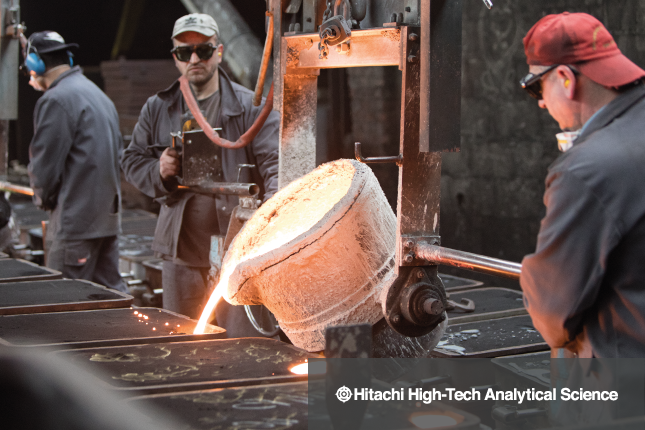When dealing with low alloy steels, manufacturing companies have a liability to be 100% sure that the chemistry properties provided on the certificate from their materials supplier are accurate before introducing the material into their process. This is to avoid recalls and, worse yet, failures that could cause physical injuries or even death for which the manufacturer is liable. These types of consequences are very real and when a failure takes place, it could be potentially devastating to a company’s reputation.
Low alloy steel (LAS), which is sometimes also referred to as high strength alloy steel (HSAL) or micro-alloyed steel, is a type of alloy with added properties to make the steel more resilient than conventional carbon steels. From a technical standpoint, low alloy steel is defined as steel which contains roughly between 1-5% of another material that has been added to the alloy. Most low alloy steels consist of carbon and iron like traditional carbon steels but additional metals have been added to the alloy mixture to increase the structural and mechanical properties. This is to achieve the desired tolerance for strength, toughness, formability, weldability, and corrosion resistance.
Depending on the desired characteristic of the metal, these other alloy elements could include copper, nickel, niobium, chromium, sulfur, boron, phosphorus, titanium or various other metals which are added to the steel to help the steel withstand the harsh conditions that it’s exposed to. HSAL and LAS steels are used for many purposes such as building structures, large piping systems, bridges, railroads, barges, farm machinery, trucks, cranes, industrial equipment, automotive, military and aerospace when the mechanical parts and pieces need to be engineered to withstand large amounts of pressure, temperature change or stress. These steels are designed to meet a specific mechanical property rather than to meet a specific chemical concentration. Moreover, it’s important to note that low alloy steels also typically contain low carbon content (0.05 to −0.25% C).

When you need 100% certainty, you should be looking toward portable or stationary spark optical emission spectroscopy (OES). ASTM International has written a standard test method known as ASTM E415-17 for analysis of carbon and low-alloy steel to be performed through spark atomic emission spectroscopy. Spark mode for OES works best because argon is introduced into the process making the measurement of carbon, nitrogen, boron, phosphorus, and sulfur possible. The use of argon is mandatory to use for two reasons:
1. Avoidance of oxidation during excitation via the plasma
2. Creation of transparency for wavelengths in the ultraviolet range (which are used for carbon, nitrogen, boron, phosphorus and other elements). Argon is transparent to this light while air absorbs wavelengths below 200nm.
Another condition of low alloy steel is that by increasing the alloy content, these steels become more difficult to weld. It becomes crucial to know the composition and material type in order to weld the alloy properly, which requires adequate precautions and controlled practices to be taken in order to avoid defects which could lead to cracks or failures. This is because lower carbon content could result in a low sensitivity to hydrogen causing a condition known as cold cracking.
Low alloy steels may also increase the need for post-weld heat treatment (PWHT). This reduces and redistributes the residual stresses in the material that have been introduced by welding which could result in risks of brittle fracture because composition influences weldability significantly. Despite their higher strength, HSLA steels can be welded at a lower preheat than would be acceptable for conventional steel.
Often when an alloyant is added to steel it becomes important to establish the equivalent carbon content for weldability. This is particularly true in the oil and gas industry which is heavily controlled by industry regulations. The carbon equivalent is achieved by converting the percentage of the alloying element(s) to represent a carbon equivalent. This also is because iron-carbon for weldability is better understood than iron-alloy; some low alloy and carbon steels can only be identified by carbon content. There are many carbon equivalent equations. Below are examples of the most common carbon equivalent equations:
Hitachi High-Tech’s OES instruments come pre-installed with the carbon equivalents along with an extensive grade database making the identification of an alloy or grade quite simple.
There are several types of elemental analysis technologies. The importance of light elements in steel products such as boron, phosphorus and sulfur means that X-ray fluorescence (XRF) isn’t always capable of measuring low amounts of ppm for phosphorus and sulfur, and it’s incapable of measuring boron and carbon.
We’re starting to see carbon analysis using handheld laser-induced breakdown spectroscopy (LIBS) analyzers but they’re not quite ready to replace OES yet because of their limitations with low limits of detection (LODs), and trace and tramp element identification for light elements other than carbon.
OES remains the best choice for low alloy steel analysis as it’s able to deliver 100% chemistry while detecting trace and tramp elements at very low levels of detection. It can also detect light elements such as carbon, nitrogen, phosphorus and boron down to ppm levels. When stakes are so high, can you afford to take a chance?
Find out more